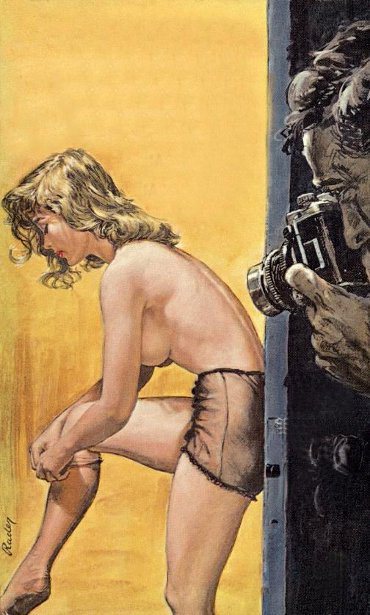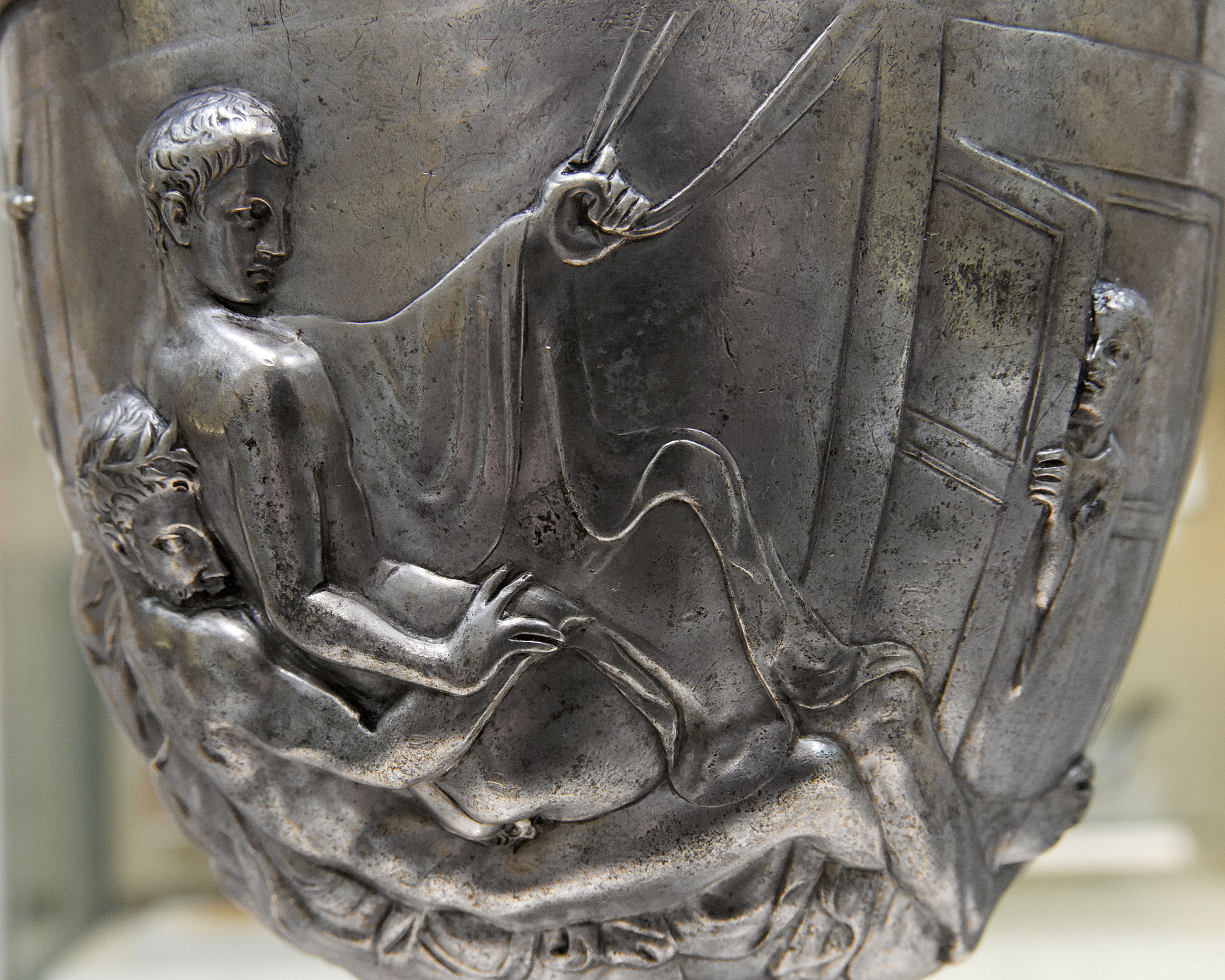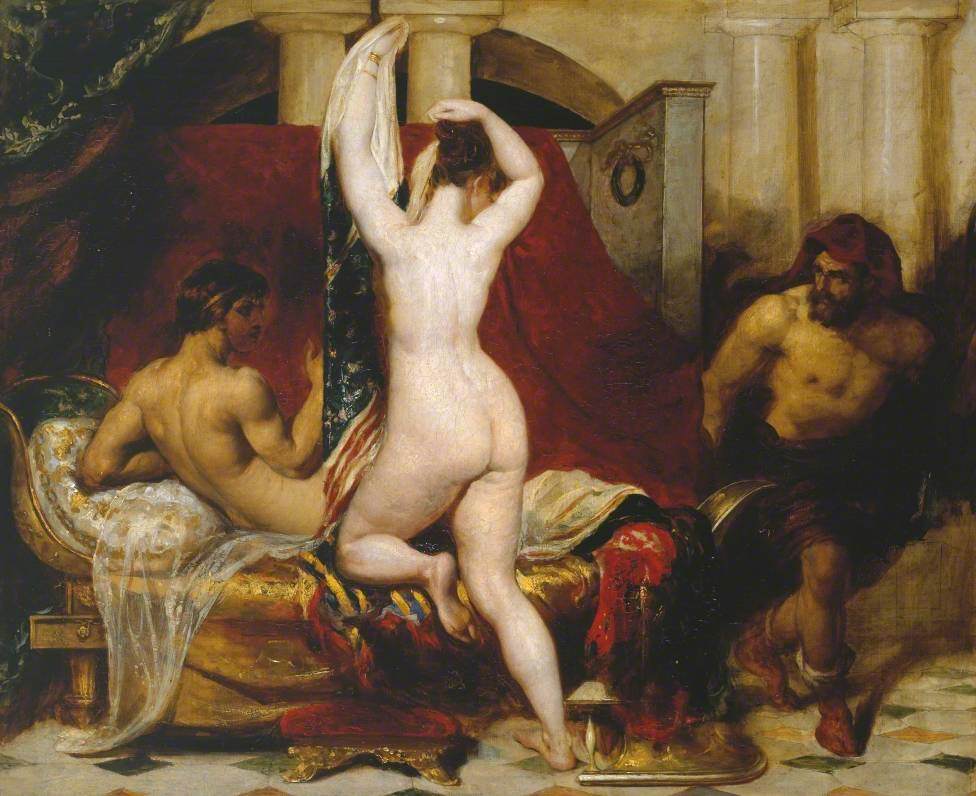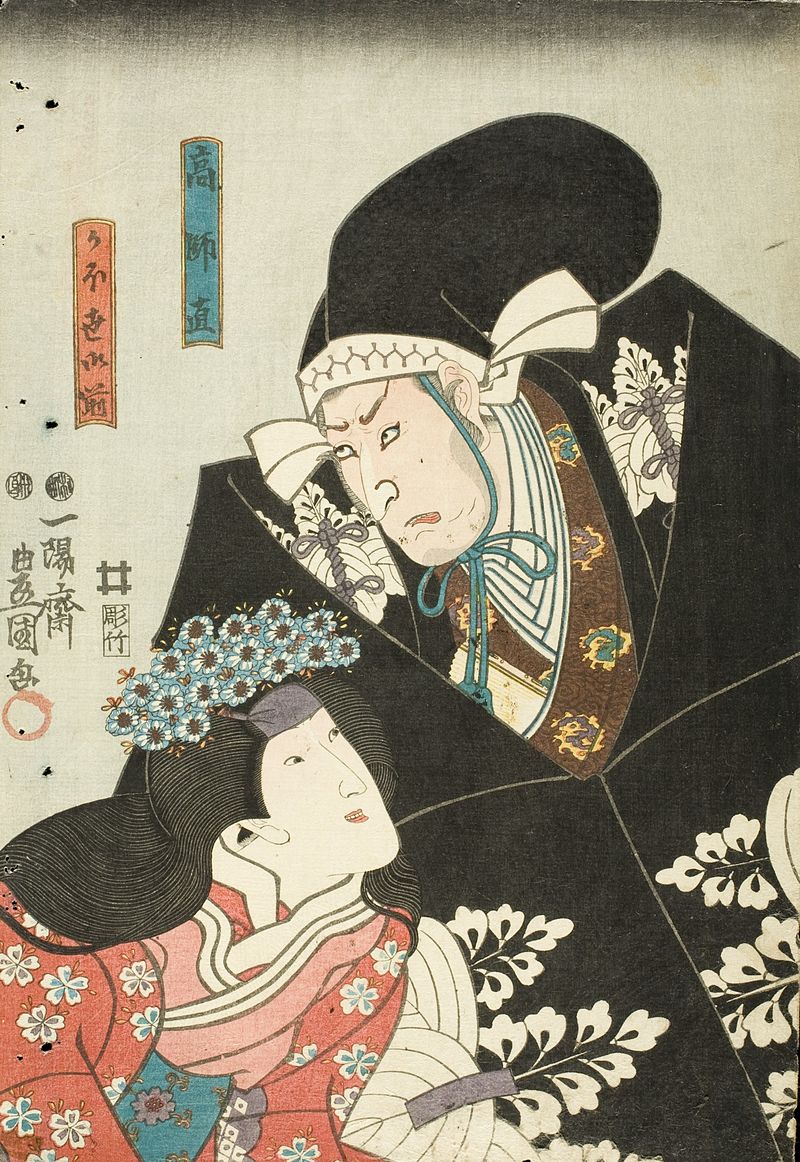Anthropology as Voyeurism

"Over Exposed" by Paul Rader(American, 1906–1986), 1962. Book by Jason Hytes, Midwood F207.
窃視症としての人類学
Anthropology as Voyeurism

"Over Exposed" by Paul Rader(American, 1906–1986), 1962. Book by Jason Hytes, Midwood F207.
解説:池田光穂
文化人類学とは、人間につい て、「文 化」という概念を中心に、経験的な調査法(=おもにインタビューと参与観察)を動員して、〈他者〉と〈他者がおりなす社会〉を観察し、そのことを 具体的に考察する学問分野です。人類学者が考える文化の概念がきわめて多義的であるととも に、人間の生活一般におけるもろもろの 現象を包摂するものであったために、文化人類学はきわめて学際的な学問であることが特徴です(→文 化人類学のさまざまな用語や概念へのリンク)。そして、文化人類学は、その学問の来歴によって制限づけられる歴史的産物でもあります(→「文化人類学」「日本文化人類学史」「人類学」)

 ☆いささか不遜
で
危険な(そして100%事実な)言い方ですが、文化人類学者ロバート・フランシ
ス・マーフィー(Robert
F. Murphy, 1924-1990)The Body Silent(1980)の著者は、文化人類学者
を、人間社会の「出歯亀(voyeur)」とまで定義しています。でばがめ(=窃視者, voyeur)するとは、相手の文
化(=異文化)に対する強烈な関心があり、また、それが妄想的な
思い込みであっても相手との関与——関係性の構築——を試みようとする企てにほかなりません。文化人類学は、人間社会の文化構築性を明らかにすると同時に、フィールドにおいて、対象社会の関係をなんらかの形で構築することであります。民族
誌(エスノグラフィー)は、人類学者と対象社会との関係性に関する再帰的な記録
であると言えましょう。
☆いささか不遜
で
危険な(そして100%事実な)言い方ですが、文化人類学者ロバート・フランシ
ス・マーフィー(Robert
F. Murphy, 1924-1990)The Body Silent(1980)の著者は、文化人類学者
を、人間社会の「出歯亀(voyeur)」とまで定義しています。でばがめ(=窃視者, voyeur)するとは、相手の文
化(=異文化)に対する強烈な関心があり、また、それが妄想的な
思い込みであっても相手との関与——関係性の構築——を試みようとする企てにほかなりません。文化人類学は、人間社会の文化構築性を明らかにすると同時に、フィールドにおいて、対象社会の関係をなんらかの形で構築することであります。民族
誌(エスノグラフィー)は、人類学者と対象社会との関係性に関する再帰的な記録
であると言えましょう。
元祖出歯亀(a voyeur)創作の中の塩冶高貞(え んや・たかさだ)※左奥。覗かれているのは妻顔世御前(出典:月岡芳 年『月百姿』(19世紀末)37「垣間見の月 かほよ」。『仮名手本忠臣蔵』 で高貞(浅野長矩)の夫人とされた顔世御前の裸婦像。奥には高師直(吉良義 央)の姿)
Voyeurism is the sexual interest in or practice of watching other people engaged in intimate behaviors, such as undressing, sexual activity, or other actions of a private nature.The term comes from the French voir which means "to see". A male voyeur is commonly labelled as "Peeping Tom" or a "Jags", a term which originates from the Lady Godiva legend. However, that term is usually applied to a male who observes somebody secretly and, generally, not in a public space.- "Mercury and Herse", scene from The Loves of the Gods by Gian Giacomo Caraglio, showing Mercury, Herse, and Aglaulos. wikipedia- Voyeurism.
覗き見あるいは窃視症(せっししょう)とは、他人が服を脱 いだり、性行為をしたり、その他プライベートな行為をしているのを見ることに性的関心を持つこと、また はそれを実践することである。この言葉は、「見る」という意味のフランス語voirから来ている。男性の覗き魔は、一般に「Peeping Tom」または「Jags」と呼ばれ、この用語はレディ・ゴディバ伝説に由来するものである。しかし、この言葉は通常、誰かを密かに観察する男性に適用さ れ、一般的に公共の空間では適用されない。 - 「マーキュリーとヘルセ」、ジャン・ジャコモ・カラグリオ作『神々の恋』の一場面で、マーキュリー、ヘルセ、アグラウロスが登場する。
Niklaus
Stoecklin (1896-1982) The Viewing,
1921.(しかしよく考えてみると、見るのは男でみられるのは女性だ→「ジェンダー・ト
ラブル」)
| Voyeurism
is the sexual interest in or practice of watching other people engaged
in intimate behaviors, such as undressing, sexual activity, or other
actions of a private nature.[1][2] The term comes from the French voir which means "to see". A male voyeur is commonly labelled as "Peeping Tom" or a "Jags", a term which originates from the Lady Godiva legend.[3] However, that term is usually applied to a male who observes somebody secretly and, generally, not in a public space. The American Psychiatric Association has classified certain voyeuristic fantasies, urges and behaviour patterns as a paraphilia in the Diagnostic and Statistical Manual (DSM-IV) if the person has acted on these urges, or the sexual urges or fantasies cause marked distress or interpersonal difficulty.[4] It is described as a disorder of sexual preference in the ICD-10.[5] The DSM-IV defines voyeurism as the act of observing "individuals, usually strangers, engaging in sexual activity, exhibitionism, or disrobing".[6] The diagnosis as a disorder would not be given to people who experience typical sexual arousal or amusement, simply by inadvertently seeing nudity or sexual activity.[7] |
窃視(あるいは窃視症)とは、脱衣、性行為、その他のプライベートな行為など、親密な行為をしている人民を観察することへの性的関心、またはその行為のことである[1][2]。 この用語は、「見る」を意味するフランス語のvoirに由来する。男性の窃視者は一般的に「ピーピング・トム(Peeping Tom)」または「ジャグズ(Jags)」と呼ばれる。 アメリカ精神医学会は、診断統計マニュアル(DSM-IV)において、人格がこれらの衝動に駆られて行動した場合、または性的衝動や妄想が顕著な苦痛や対 人的困難を引き起こした場合、特定の覗き見的妄想、衝動、行動パターンをパラフィリアとして分類している[4]。 [5] DSM-IVでは、窃視を「個人(通常は見知らぬ人)が性行為、露出行為、または脱衣行為を行っているのを観察する行為」と定義している[6]。裸体や性 行為をうっかり見ただけで、典型的な性的興奮や娯楽を経験する人民には、障害としての診断は下されない[7]。 |
| Historical perspectives There is relatively little academic research regarding voyeurism. When a review was published in 1976 there were only 15 available resources.[8] Voyeurs were well-paying hole-lookers in especially Parisian brothels, a commercial innovation described as far back as 1857 but not gaining much notoriety until the 1880s, and not attracting formal medical-forensic recognition until the early 1890s.[9] Society has accepted the use of the term voyeur as a description of anyone who views the intimate lives of others, even outside of a sexual context.[10] This term is specifically used regarding reality television and other media which allow people to view the personal lives of others. This is a reversal from the historical perspective, moving from a term which describes a specific population in detail, to one which describes the general population vaguely. One of the few historical theories on the causes of voyeurism comes from psychoanalytic theory. Psychoanalytic theory proposes that voyeurism results from a failure to accept castration anxiety and as a result of failure to identify with the father.[6] |
歴史的視点 窃視に関する学術的研究は比較的少ない。窃視者は、特にパリの売春宿の高給取りの覗き魔であり、1857年までさかのぼるが、1880年代まであまり知ら れることはなく、1890年代初頭まで医学的・法医学的に正式に認知されることはなかった。 [9] 社会は、性的な文脈以外であっても、他人の親密な生活を閲覧する人に対する説明として、窃視者という用語の使用を受け入れている[10]。この用語は、リ アリティ・テレビや、人民が他人の私生活を閲覧できるようにするその他のメディアに関して特に使用されている。これは歴史的な観点からの逆転であり、特定 の集団を詳細に説明する用語から、一般集団を漠然と説明する用語へと移行している。 窃視の原因に関する数少ない歴史的理論のひとつは、精神分析理論に由来する。精神分析理論では、窃視は去勢不安を受け入れられず、父親と同一化できなかった結果として生じる、と提唱している[6]。 |
| Prevalence Voyeurism has high prevalence rates in most studied populations. Voyeurism was once believed to only be present in a small portion of the population. This perception changed when Alfred Kinsey discovered that 30% of men prefer coitus with the lights on.[6] This behaviour is not considered voyeurism by modern diagnostic standards, but there was little differentiation between normal and pathological behaviour at the time. Subsequent research showed that 65% of men had engaged in peeping, which suggests that this behaviour is widely spread throughout the population.[6] Congruent with this, research found voyeurism to be the most common sexual law-breaking behaviour in both clinical and general populations.[11] An earlier study, based on 60 college men from a rural area, indicates that 54% had voyeuristic fantasies, and that 42% had tried voyeurism, concluding that young men are more easily aroused by the idea.[12] In a national study of Sweden it was found that 7.7% of the population (16% of men and 4% of women) had engaged in voyeurism at some point.[13] It is also believed that voyeurism occurs up to 150 times more frequently than police reports indicate.[13] This same study also indicates that there are high levels of co-occurrence between voyeurism and exhibitionism, finding that 63% of voyeurs also report exhibitionist behaviour.[13] |
有病率 窃視はほとんどの調査集団で高い有病率を示している。窃視はかつて人口のごく一部にしか存在しないと考えられていた。この認識が変わったのは、アルフレッ ド・キンゼーが、男性の30%が明かりをつけたままの性交渉を好むことを発見したときである。その後の調査では、男性の65%が盗撮を行ったことがあるこ とが示されており、この行動が広く人口に膾炙していることが示唆されている[6]。 これと一致するように、臨床集団と一般集団の両方において、盗撮が最も一般的な性的掟破りの行動であることが調査で明らかになっている[11]。地方に住 む60人の大学生男性を対象とした先行研究では、54%が盗撮妄想を抱いており、42%が盗撮を試みたことがあることが示されており、若い男性はこの考え に興奮しやすいと結論付けられている[12]。 スウェーデンの国民調査では、人口の7.7%(男性の16%、女性の4%)が、ある時点で盗撮行為に及んだことがあることがわかった[13]。 また、盗撮行為は、警察発表の150倍以上の頻度で発生していると考えられている[13]。 この同じ調査では、盗撮行為と展示行為の間には高いレベルの共起性があることも示されており、盗撮者の63%が展示行為も報告していることがわかった [13]。 |
| Characteristics People engage in voyeuristic behaviours for diverse reasons, but statistics can indicate which groups are likelier to engage in the act. Early research indicated that voyeurs were more mentally healthy than other groups with paraphilias.[8] Compared to the other groups studied, it was found that voyeurs were unlikely to be alcoholics or drug users. More recent research shows that, compared to the general population, voyeurs were moderately more likely to have psychological problems, use alcohol and drugs, and have higher sexual interest generally.[13] This study also shows that voyeurs have a greater number of sexual partners per year, and are more likely to have had a same-sex partner than most of the populations.[13] Both older and newer research found that voyeurs typically have a later age of first sexual intercourse.[8][13] However, other research found no difference in sexual history between voyeurs and non-voyeurs.[12] Voyeurs who are not also exhibitionists tend to be from a higher socioeconomic status than those who do show exhibitionist behaviour.[13] |
特徴 人民が盗撮行為に及ぶ理由は様々であるが、統計によって、どのグループが盗撮行為に及ぶ可能性が高いかを示すことができる。 初期の研究では、窃視者は他のパラフィリア集団よりも精神的に健康であることが示された[8]。より最近の研究では、一般集団と比較して、窃視者は心理的 問題を抱え、アルコールや薬物を使用し、一般的に性的関心が高い傾向が中程度に高いことが示された[13]。この研究はまた、窃視者はほとんどの集団より も年間の性的パートナーの数が多く、同性のパートナーを持ったことがある可能性が高いことを示している。 [13]古い研究でも新しい研究でも、窃視者は一般的に初回性交年齢が遅いことが判明している[8][13]。しかし、他の研究では、窃視者と非窃視者の 間に性遍歴の差はないことが判明している[12]。 |
Gender differences Sex between male youths spied on by man and woman. The Dinos Painter, fifth century BCE.  Woman spies on male couple, 18th-century, Qing-Dynasty. Research shows that, like almost all paraphilias, voyeurism is more common in men than in women.[13] However, research has found that men and women both report roughly the same likelihood that they would hypothetically engage in voyeurism.[14] There appears to be a greater gender difference when actually presented with the opportunity to perform voyeurism. There is very little research done on voyeurism in women, so very little is known on the subject which limits the degree to which it can generalize to normal female populations.[15] A 2021 study found that 36.4% of men and 63.8% of women were strongly repulsed by the idea of voyeurism. Men were more likely to be mildly or moderately aroused than women, but there was little gender difference among those who reported strong arousal. Men reported slightly higher willingness to commit voyeurism but, when risk is introduced, willingness diminishes in both sexes proportionally to the risk involved. Individual differences in sociosexuality and sexual compulsivity were found to contribute to the sex differences in voyeurism.[16] |
男女の異なる性 男女に覗かれた男性若者のセックス。ディノスの画家、紀元前5世紀。  男性カップルを覗き見する女性(18世紀、清朝)。 研究によると、ほとんどすべてのパラフィリアと同様に、窃視は女性よりも男性に多くみられる[13]。しかし、仮説として窃視を行う可能性は、男女ともに ほぼ同じであることが研究で報告されている[14]。実際に窃視を行う機会が与えられた場合には、より大きな性差があるようである。女性の窃視に関する研 究はほとんど行われていないため、通常の女性集団に一般化できる程度を制限するようなことはほとんど知られていない[15]。 2021年の調査では、男性の36.4%、女性の63.8%が窃視という考えに強い嫌悪感を抱いていた。男性は女性よりも軽度または中等度の興奮を覚える 傾向が強かったが、強い興奮を覚えたと報告した人の間では性差はほとんどなかった。男性は窃視行為に対する意欲がやや高いと報告したが、リスクが生じる と、男女ともにそのリスクに比例して意欲が低下する。社会性と性的強迫性における個人差が窃視の性差に寄与していることが明らかになった[16]。 |
Contemporary perspectives The Lady Godiva Clock in Coventry displays her naked ride through the city and Peeping Tom's voyeurism.  A man spies on two males having intercourse in side A of the Warren Cup Lovemap theory suggests that voyeurism exists because looking at naked others shifts from an ancillary sexual behaviour to a primary sexual act.[14] This results in a displacement of sexual desire making the act of watching someone the primary means of sexual satisfaction. Voyeurism has also been linked with obsessive–compulsive disorder (OCD). When treated by the same approach as OCD, voyeuristic behaviours significantly decrease.[17] |
現代の視点 コベントリーのレディ・ゴディバ・クロックは、彼女の裸で街を駆け抜ける姿と、ピーピング・トムの窃視を映し出している。  ウォーレン・カップのサイドAで、2人の男性が性交しているのを覗き見する男。 ラブマップ理論によれば、窃視が存在するのは、他人の裸を見ることが付随的な性行動から主要な性行為に移行するためである[14]。その結果、性的欲求が変位し、誰かを見る行為が性的満足の主要な手段となる。 窃視は強迫性障害(OCD)とも関連している。強迫性障害と同じアプローチで治療すると、盗撮行為は有意に減少する[17]。 |
| Treatment Professional treatment Historically voyeurism has been treated in a variety of ways. Psychoanalytic, group psychotherapy and shock aversion approaches have all been attempted with limited success.[8] There is some evidence which shows that pornography can be used as a form of treatment for voyeurism. This is based on the idea that countries with pornography censorship have high amounts of voyeurism.[18] Additionally shifting voyeurs from voyeuristic behaviour, to looking at graphic pornography, to looking at the nudes in Playboy has been successfully used as a treatment.[19] These studies show that pornography can be used as a means of satisfying voyeuristic desires without breaking the law. Voyeurism has also been successfully treated with a mix of anti-psychotics and antidepressants. However the patient in this case study had a multitude of other mental health problems. Intense pharmaceutical treatment may not be required for most voyeurs.[20] There has also been success in treating voyeurism through using treatment methods for obsessive compulsive disorder. There have been multiple instances of successful treatment of voyeurism through putting patients on fluoxetine and treating their voyeuristic behaviour as a compulsion.[10][17] |
治療 専門家による治療 歴史的に、窃視はさまざまな方法で治療されてきた。精神分析、集団精神療法、ショック回避のアプローチなどが試みられてきたが、成功例は限られている [8]。これは、ポルノグラフィーの検閲がある国では窃視が多いという考えに基づいている[18]。さらに、窃視者を窃視的行動から生々しいポルノを見る こと、『プレイボーイ』のヌードを見ることにシフトさせることが、治療法として成功した[19]。これらの研究は、法律を犯すことなく窃視的欲求を満たす 手段としてポルノグラフィーを使用できることを示している。 窃視症は、抗精神病薬と抗うつ薬の混血による治療にも成功している。しかし、この事例の患者は、他にもマルチチュードな精神保健上の問題を抱えていた。ほとんどの窃視者には、強力な薬物治療は必要ないかもしれない[20]。 強迫性障害の治療法を用いて窃視の治療に成功した例もある。患者にフルオキセチンを服用させ、盗撮行動を強迫として治療することで、窃視の治療に成功した例が複数ある[10][17]。 |
| Techniques The increased miniaturisation of hidden cameras and recording devices since the 1950s has enabled those so minded to surreptitiously photograph or record others without their knowledge and consent. The vast majority of mobile phones, for example, are readily available to be used for their camera and recording ability. |
テクニック 1950年代以降、隠しカメラや録画装置の小型化が進み、その気になれば、他人の知らないところで、また同意なしに、こっそり撮影したり録画したりすることができるようになった。例えば、携帯電話の大部分は、カメラや録画機能を備えているため、すぐに利用できる。 |
| Criminology Non-consensual voyeurism is considered to be a form of sexual abuse.[21][22][irrelevant citation][23][irrelevant citation] When the interest in a particular subject is obsessive, the behaviour may be described as stalking. The United States FBI assert that some individuals who engage in "nuisance" offences (such as voyeurism) may also have a propensity for violence based on behaviours of serious sex offenders.[24] An FBI researcher has suggested that voyeurs are likely to demonstrate some characteristics that are common, but not universal, among serious sexual offenders who invest considerable time and effort in the capturing of a victim (or image of a victim); careful, methodical planning devoted to the selection and preparation of equipment; and often meticulous attention to detail.[25] Little to no research has been done into the demographics of voyeurs. |
犯罪学 合意のない窃視は性的虐待の一形態と考えられている[21][22][無関係な引用][23][無関係な引用] 特定の対象への関心が強迫的な場合、その行動はストーキングと表現されることがある。 FBIの研究者は、窃視者は、被害者(または被害者の画像)の捕獲にかなりの時間と労力を費やす深刻な性犯罪者に共通する、しかし普遍的ではないいくつかの特徴を示す可能性が高いと示唆している。 窃視者の属性については、ほとんど調査されていない。 |
| Legal status Voyeurism is not a crime in common law. In common law countries, it is only a crime if made so by legislation. Canada In Canada, for example, voyeurism was not a crime when the case Frey v. Fedoruk et al. arose in 1947. In that case, in 1950, the Supreme Court of Canada held that courts could not criminalise voyeurism by classifying it as a breach of the peace and that Parliament would have to specifically outlaw it. A test of the lack of laws related to voyeurism came in February 2005. It became public knowledge that a website called peepingthong.com had become a depository of photos showing young women, many of them University of Victoria students, sitting down at various campus locations, such as libraries. While the act of photographing them in isolation may not have caused a commotion, each of the women revealed their thong underwear to create a whale tail.[26] Reaction from female members of the university community was not positive. The chairwoman of the student union, Joanna Groves, believed that perpetrator(s) committed an action that were “a violation of someone’s privacy.”[26] The outreach coordinator for the University of Victoria Student Society Women's Centre, Caitlin Warbeck, went as far as to call it “sexual assault.”[27] The photographed individuals also appeared to be completely unaware that they were being watched.[26] While the photos did cause a commotion, law enforcement could not do anything because the photos were snapped in public locations. University administrators were also powerless because the site was not affiliated with the institution.[26] Campus security, however, did put up flyers in certain parts of campus where the perpetrator(s) were believed to be operating.[28] On November 1, 2005, Parliament outlawed voyeurism when section 162 was added to the Canadian Criminal Code, declaring voyeurism to be a sexual offence when it violates a reasonable expectation of privacy.[29] In the case of R v Jarvis, the Supreme Court of Canada held that for the purposes of that law, the expectation of privacy is not all-or-nothing; rather there are degrees of privacy, and although secondary-school pupils in the school building cannot reasonably expect as much privacy as in the bedroom, nonetheless they can expect enough privacy so that photographing them without their consent for the purpose of sexual gratification is forbidden.[30] |
法的地位 窃視はコモン・ローでは犯罪ではない。コモン・ローの国々では、法律で定められた場合のみ犯罪となる。 カナダ 例えばカナダでは、1947年にFrey v. Fedoruk et al.事件が発生した時点では、窃視は犯罪ではなかった。この事件で1950年、カナダ最高裁判所は、裁判所は窃視を平和侵害に分類して犯罪とすることは できず、議会が特に違法としなければならないと判示した。 2005年2月、窃視に関する法律の欠如が試された。peepingthong.comというウェブサイトが、若い女性(その多くはビクトリア大学の学 生)が図書館などキャンパスのさまざまな場所で座っている姿を撮影した写真の保管場所になっていることが公になったのだ。彼女たちを単独で撮影する行為は 騒動にはならなかったかもしれないが、女性たちはそれぞれTバックの下着を露出して鯨の尻尾を作った[26]。 大学コミュニティの女性メンバーからの反応は肯定的なものではなかった。学生組合のジョアンナ・グローブス委員長は、犯人は「誰かのプライバシーを侵害す る行為」をしたと考えていた[26]。ビクトリア大学学生協会女性センターのアウトリーチ・コーディネーターのケイトリン・ウォーベックは、これを「性的 暴行」とまで呼んだ[27]。 写真は騒ぎを引き起こしたが、写真は公共の場所で撮影されたため、警察当局は何もできなかった。しかし、キャンパスの警備員は、犯人が活動していると思われるキャンパスの特定の場所にチラシを貼った[28]。 2005年11月1日、カナダ刑法に第162条が追加され、プライバシーの合理的な期待を侵害する場合、窃視は性犯罪であると宣言したとき、議会は窃視を 非合法化した。 [29]カナダ最高裁判所は、R v Jarvis事件において、同法の目的上、プライバシーの期待はオール・オア・ナッシングではなく、むしろプライバシーの程度があり、校舎内の中等学校の 生徒には寝室内のようなプライバシーを合理的に期待することはできないが、それにもかかわらず、性的満足を得る目的で同意なしに撮影することは禁止される よう、十分なプライバシーを期待することができると判示した[30]。 |
| United Kingdom In some countries voyeurism is considered to be a sex crime. In the United Kingdom, for example, non-consensual voyeurism became a criminal offence on May 1, 2004.[31] In the English case of R v Turner (2006),[32] the manager of a sports centre filmed four women taking showers. There was no indication that the footage had been shown to anyone else or distributed in any way. The defendant pleaded guilty. The Court of Appeal confirmed a sentence of nine months' imprisonment to reflect the seriousness of the abuse of trust and the traumatic effect on the victims. In another English case in 2009, R v Wilkins (2010),[33][34] a man who filmed his intercourse with five of his lovers for his own private viewing was sentenced to eight months in prison and ordered to sign onto the Sex Offender Register for ten years. In 2013, 40-year-old Mark Lancaster was found guilty of voyeurism and jailed for 16 months. He had tricked an 18-year-old student into traveling to a rented flat in Milton Keynes. There, he had filmed her with four secret cameras dressing up as a schoolgirl and posing for photographs before he had sex with her.[35] In a more recent English case in 2020, the Court of Appeal upheld the conviction of Tony Richards. Richards had sought "to have two voyeurism charges under section 67 of the Sexual Offences Act dismissed on the grounds that he had committed no crime".[36][37] Richards had "secretly videoed himself having sex with two women who had consented to sex in return for money but had not agreed to being captured on camera".[38] In an unusual step, the court allowed Emily Hunt, a person not involved in the case, to intervene on behalf of the Crown Prosecution Service (CPS). Hunt had an ongoing judicial review against the CPS. The CPS had argued that Hunt's alleged attacker had not violated the law when he "took a video lasting over one minute of her naked and unconscious" in a hotel room -- the basis being that there should be no expectation of privacy in the bedroom. However, in terms of what is considered a private act for the purposes of voyeurism, the CPS was arguing the opposite in the Richards appeal.[37][38] The Court of Appeal clarified that consenting to sex in a private place does not amount to consent to be filmed without that person's knowledge. Anyone who films or photographs another person naked, without their permission, is breaking the law under sections 67 and 68 of the Sexual Offences Act.[36][39] |
イギリス 一部の国では窃視は性犯罪とみなされている。例えばイギリスでは、2004年5月1日に、合意のない窃視が刑事犯罪となった[31]。イギリスのR v Turner事件(2006年)[32]では、スポーツセンターの支配人が4人の女性がシャワーを浴びているところを撮影した。その映像が誰かに見せられ たり、何らかの形で配布されたりした形跡はなかった。被告は有罪を主張した。控訴裁判所は、信頼の濫用の重大性と被害者へのトラウマ的影響を考慮し、禁固 9カ月の判決を確定した。 2009年の別の英国の事件であるR v Wilkins (2010)[33][34]では、5人の恋人との性交を自分の個人的な閲覧のために撮影した男に8カ月の禁固刑が言い渡され、10年間の性犯罪者登録へ の署名が命じられた。2013年には、40歳のマーク・ランカスターが窃視の罪で有罪となり、16カ月の実刑判決を受けた。彼は18歳の学生を騙して、ミ ルトン・ケインズの賃貸アパートに旅行させた。そこで彼は、彼女とセックスする前に、女子学生の格好をして写真撮影に応じる姿を4台の隠しカメラで撮影し ていた[35]。 2020年のより最近のイギリスの事件では、控訴裁判所はトニー・リチャーズの有罪判決を支持した。リチャーズは「犯罪を犯していないという理由で、性犯 罪法第67条に基づく2つの窃視罪を棄却してもらう」ことを求めていた[36][37]。リチャーズは「金銭と引き換えにセックスに同意していたが、カメ ラに撮られることには同意していなかった2人の女性とセックスしているところを密かにビデオに撮っていた」[38]。異例の措置として、裁判所は、この事 件とは無関係の人格であるエミリー・ハントがクラウン検察局(CPS)に代わって介入することを認めた。ハントはCPSに対して司法審査を継続中だった。 CPSは、ハントの加害者とされる人物がホテルの一室で「彼女の全裸と意識不明を1分以上にわたって撮影した」場合、法に違反していないと主張していた。 しかし、窃視の目的上、何が私的行為とみなされるかについては、CPSはリチャーズ控訴審で逆の主張をしていた[37][38]。控訴裁判所は、私的な場 所でのセックスに同意することは、その人格が知らないうちに撮影されることに同意することにはならないことを明らかにした。人格の許可なく他人の裸を撮影 したり写真に撮ったりする者は、性犯罪法第67条と第68条の下で法を犯している[36][39]。 |
| United States In the United States, criminal voyeurism statutes arise from laws and legal principles that protect private activities from unlawful intrusion.[40] They are specific to unlawful, unconsented surreptitious surveillance, recordings, and broadcasts.[41] They involve places and times when a person has a reasonable expectation of privacy and a reasonable supposition they are not being photographed, filmed or observed by any form of recording or broadcast device.[42] These statutes often also criminalize the broadcast, dissemination, publication, or selling of recordings.[43] Video voyeurism is an offense in at least twelve states.[44] The case that led to the criminalisation of video voyeurism has been made into a television movie called Video Voyeur. |
米国 米国では、違法な侵入から私的活動を保護する法律や法原則に基づき、盗視罪が制定されている[40]。 違法で無許可の盗撮、録画、放送に特化したものであり[41]、人格がプライバシーを合理的に期待し、いかなる形式の録画・放送装置によっても撮影、撮 影、観察されていないと合理的に推測できる場所や時間を対象とする[42]。 ビデオ窃視は、少なくとも12の州で犯罪とされている[44]。ビデオ窃視が犯罪とされるきっかけとなった事件は、『ビデオ窃視』というテレビ映画にもなっている。 |
| Saudi Arabia Saudi Arabia banned the sale of camera phones nationwide in April 2004, but reversed the ban in December 2004. Some countries, such as South Korea and Japan, require all camera phones sold in their country to make a clearly audible sound whenever a picture is being taken. In South Korea, specialty teams have been set up to regularly check places like bathrooms and change-rooms for hidden cameras known as "molka".[45] |
サウジアラビア サウジアラビアは2004年4月、全国的にカメラ付き携帯電話の販売を禁止したが、2004年12月に禁止を撤回した。韓国や日本など一部の国では、その 国で販売されるすべてのカメラ付き携帯電話に対し、撮影時にはっきりと聞こえる音を出すことを義務付けている。韓国では、「モルカ」と呼ばれる隠しカメラ がトイレや更衣室などにないか定期的にチェックする専門チームが設置されている[45]。 |
| India In 2013, the Indian Parliament made amendments to the Indian Penal Code, introducing voyeurism as a criminal offence.[46] A man committing the offence of voyeurism would be liable for imprisonment of not less than one year and up to three years and a fine for the first offence. For any subsequent conviction, he would be liable for imprisonment for not less than three years and up to seven years as well as a fine. |
インド 2013年、インド議会はインド刑法を改正し、犯罪として窃視を導入した[46]。窃視の罪を犯した者は、初犯の場合、1年以上3年以下の禁固刑と罰金刑に処せられる。それ以降の有罪判決に対しては、3年以上7年以下の禁固刑と罰金刑が科される。 |
| Singapore Voyeurism is generally deemed illegal in Singapore. Those convicted of voyeurism face a maximum punishment of one year in jail and a fine -- based on insulting a woman's modesty.[47] Recent cases in 2016 include the sentencing of church facility manager Kenneth Yeo Jia Chuan who filmed women in toilets. Yeo Jia Chuan planted pinhole cameras in a handicapped toilet at the Church of Singapore at Bukit Timah, and in the unisex toilet of the church's office at Bukit Timah Shopping Centre.[48][49] Secret photography by law enforcement authorities is called surveillance and is not considered to be voyeurism, though it may be unlawful or regulated in some countries. |
シンガポール シンガポールでは一般的に窃視は違法とされている。窃視罪で有罪判決を受けた者は、女性の慎みを侮辱したことを理由に、最高で懲役1年と罰金に処される [47]。 2016年の最近の事例では、トイレで女性を撮影した教会施設管理者のケネス・ヨー・ジア・チュアンに対する判決がある。Yeo Jia Chuanは、ブキティマにあるシンガポール教会の障害者用トイレと、ブキティマ・ショッピングセンターにある教会事務所の男女兼用トイレにピンホールカ メラを仕掛けた[48][49]。 法執行当局による盗撮は監視と呼ばれ、窃視とはみなされないが、国によっては違法または規制されている場合もある。 |
| Popular culture Films Voyeurism is a main theme in films such as The Secret Cinema (1968), Peepers (2010), and Sliver (1993), based on a book of the same name by Ira Levin. Voyeurism is a common plot device in both: Serious films, e.g., Rear Window (1954), Klute (1971), Blue Velvet (1986), Dekalog: Six / A Short Film About Love (1988), Disturbia (2007), and X (2022) and Humorous films, e.g., Animal House (1978), Gregory's Girl (1981), Porky's (1981), Revenge of the Nerds (1984), Back to the Future (1985), American Pie (1999), and Semi-Pro (2008) Voyeuristic photography has been a central element of the mis-en-scene of films such as: Michael Powell's Peeping Tom (1960), and Michelangelo Antonioni's Blowup (1966) Pedro Almodovar's Kika (1993) deals with both sexual and media voyeurism. In Malèna, a teenage boy constantly spies on the title character. The television movie Video Voyeur: The Susan Wilson Story (2002) is based on a true story about a woman who was secretly videotaped and subsequently helped to get laws against voyeurism passed in parts of the United States.[50] Voyeurism is a key plot device in the Japanese movie Love Exposure (Ai no Mukidashi). The main character Yu Honda takes upskirt photos to find his 'Maria' to become a man and get his first taste of sexual stimulation.  Candaules, King of Lydia, Shews his Wife by Stealth to Gyges, One of his Ministers, as She Goes to Bed by William Etty. This image illustrates Herodotus's version of the tale of Gyges (see: candaulism). Literature In the light novel series Baka to Test to Shōkanjū, Kōta Tsuchiya is subject to voyeurism, explaining why he is referred to as "Voyeur". Manga The manga Colourful, Nozo×Kimi and Nozoki Ana included elements of voyeurism in their plot. Music "Voyeur", the second track on blink-182's album Dude Ranch, written by Tom DeLonge, features explicit references to the practice of voyeurism. "Sirens", also written by DeLonge, from Angels & Airwaves' album I-Empire is also about voyeurism, albeit in a more subtle way. "Persiana Americana”, famous track made by Argentinian band Soda Stereo features a narrator who is actively watching an exhibitionist woman. Gimme, 2023 single by Sam Smith, Koffee and Jessie Reyez, references voyeurism. Photography Merry Alpern with her works, Dirty Windows, 1993–1994.[51] Kohei Yoshiyuki with his works called The Park.[52] |
大衆文化 映画 窃視は、『秘密の映画館』(1968年)、『のぞきめ』(2010年)、アイラ・レヴィンの同名小説を原作とした『スリヴァー』(1993年)といった映画の主要テーマである。 いずれも窃視がよく使われるプロットである: シリアスな映画、例えば『裏窓』(1954年)、『Klute』(1971年)、『ブルーベルベット』(1986年)、『Dekalog: Six / A Short Film About Love』(1988年)、『ディスタービア』(2007年)、『X』(2022年)などである。 ユーモア映画、例えば『アニマル・ハウス』(1978年)、『グレゴリーズ・ガール』(1981年)、『ポーキーズ』(1981年)、『オタクの復讐』 (1984年)、『バック・トゥ・ザ・フューチャー』(1985年)、『アメリカン・パイ』(1999年)、『セミ・プロ』(2008年)など。 盗撮は、次のような映画のミス・シーンの中心的要素である: マイケル・パウエルの『ピーピング・トム』(1960年)や ミケランジェロ・アントニオーニの『ブロウアップ』(1966年)。 ペドロ・アルモドバルの『キカ』(1993年)は、性的窃視とメディア窃視の両方を扱っている。 Malèna』では、10代の少年が主人公を常に覗き見している。 テレビ映画『Video Voyeur: スーザン・ウィルソン物語』(2002年)は、密かにビデオに撮られ、その後アメリカの一部で窃視を禁止する法律を成立させるのに貢献した女性の実話に基づいている[50]。 窃視は、日本映画『愛のむきだし』の重要なプロット・デバイスである。主人公の本田優は、男になるための「マリア」を見つけ、性的刺激を初めて味わうために、スカートめくり写真を撮る。  リディアの王カンダウレスは、大臣ギュゲスにこっそり妻を見せる。この画像は、ヘロドトス版ギュゲスの物語(参照:カンダウリズム)を示している。 文学 ライトノベル『バカとテストと召喚獣』シリーズでは、土屋公太が窃視症である。 マンガ 漫画『カラフル』、『ノゾ×キミ』、『ノゾキ穴』には窃視の要素が含まれている。 音楽 トム・デロンゲが作曲したblink-182のアルバム『Dude Ranch』の2曲目に収録されている 「Voyeur 」には、窃視行為に関する露骨な言及がある。 エンジェルズ&エアウェイブスのアルバム『I-Empire』に収録されている、同じくデロンゲ作詞作曲の 「Sirens 」も、より微妙な形ではあるが、窃視をテーマにしている。 アルゼンチンのバンド、ソーダ・ステレオが作った有名な曲、「Persiana Americana 」は、露出狂の女性を積極的に監視するナレーターをフィーチャーしている。 サム・スミス、コフィー、ジェシー・レイズの2023年のシングル「Gimme」は、窃視に言及している。 写真 メリー・アルパーンと彼女の作品『Dirty Windows』(1993-1994年)[51]。 吉行耕平の作品『The Park』[52]。 |
| Courtship disorder Exhibitionism Frey v. Fedoruk et al. Gaze Male gaze Invasion of privacy Peep show Sex show Scopophobia, the fear of being stared at Scopophilia, an aesthetic pleasure drawn from looking at an object or a person. Sexual attraction Striptease Upskirt Whale Tail Johns Hopkins Hospital#Controversies - a male gynecologist at JHH took voyeuristic photographs of more than 8,000 patients. |
求愛障害 エキシビジョニズム フレイ対フェドルク他 視線 男性の視線 プライバシーの侵害 のぞき見 セックス・ショー スコポフォビア(Scopophobia):凝視されることへの恐怖。 スコポフィリア(Scopophilia):物や人格を見ることから美的快楽を得ること。 性的魅力 ストリップショー アップスカート クジラの尻尾 ジョンズ・ホプキンス病院#論争-JHHの男性婦人科医が8,000人以上の患者を盗撮した。 |
| https://en.wikipedia.org/wiki/Voyeurism |
リンク
文献
その他の情報
より詳しい説明は〈こちら〉を読みましょう!
次のページでのおさらいをしましょう!
〈リ ンク〉
Copyleft, CC, Mitzub'ixi Quq Chi'j, 1996-2099

「大序」 四代目坂東三津五郎の高師直、三代目岩井粂三郎のかほ世御前。嘉永2年 (1849 年)7月、江戸中村座。三代目歌川豊国画。
++
Copyleft,
CC, Mitzub'ixi Quq Chi'j, 1996-2099